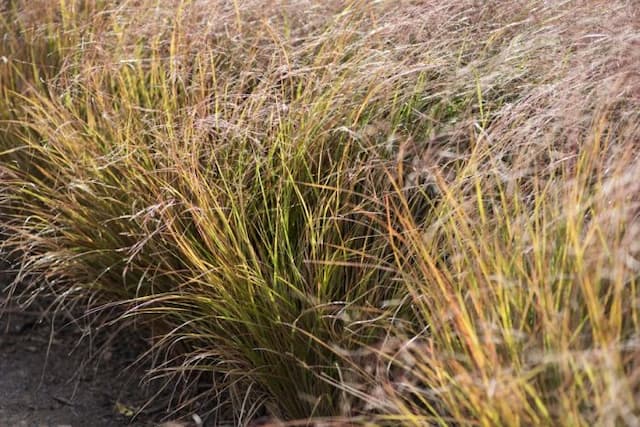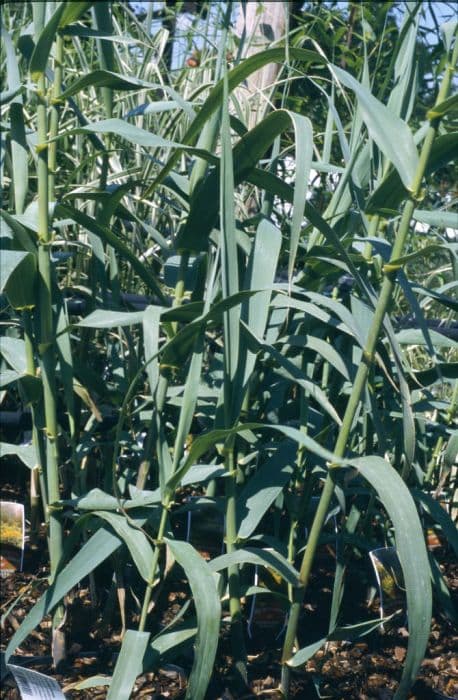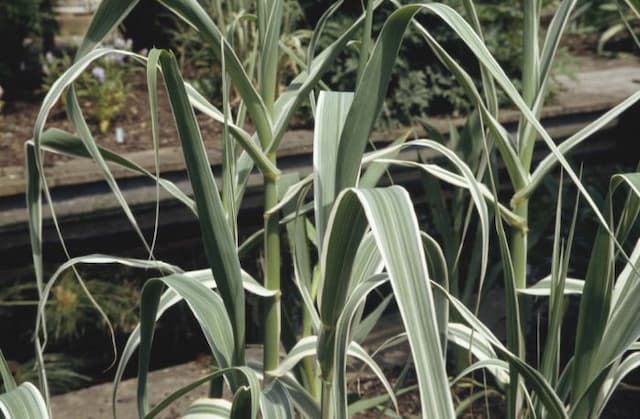Himalayan Fairy Grass Miscanthus nepalensis

ABOUT
The plant known as Himalayan fairy grass showcases a lush, tufted, and clumping form. Its appearance is characterized by a graceful foliage of slender, arching leaves with a green shade that might bear a silver midrib, adding a touch of elegance to its visual appeal. During the flowering season, Himalayan fairy grass produces feathery flower plumes which may carry a soft, pinkish to silvery hue, contributing to its delicate aesthetic. The plumes stand aloft the foliage and can give a hazy, almost ethereal effect, especially when backlit by the early morning or late afternoon sun. As the season progresses, the flowers can turn into a straw color, offering a new dimension of visual interest and texture. The leaves themselves often turn into orange, red or purple shades as the cooler months arrive, providing a beautiful display of fall colors.
About this plant
 Names
NamesFamily
Poaceae
Synonyms
Nepal Fairy Grass, Himalayan Fairy Grass
Common names
Erianthus nepalensis, Saccharum nepalense, Miscanthus tinctorius, Miscanthus violaceus.
 Toxicity
ToxicityTo humans
Himalayan Fairy Grass is not widely known for being toxic to humans. There is limited information available on the toxicity of Himalayan Fairy Grass to humans, and it is not commonly listed as a poisonous plant. However, as with many plants, it is advisable to exercise caution and avoid ingesting parts of plants that are not known to be safe for consumption.
To pets
Himalayan Fairy Grass is not widely recognized for being toxic to pets. There is limited information available regarding its toxicity in pets such as dogs and cats, and it is not commonly reported to be a poisonous plant. Nevertheless, pet owners should generally prevent pets from eating ornamental grasses or plants that are not specifically known to be safe, as they can sometimes cause gastrointestinal upset or other health issues.
 Characteristics
CharacteristicsLife cycle
Perennials
Foliage type
Deciduous
Color of leaves
Green
Flower color
Varies
Height
6 feet (1.83 meters)
Spread
3 feet (0.91 meters)
Plant type
Grass
Hardiness zones
7
Native area
Nepal
Benefits
 General Benefits
General Benefits- Ornamental value: Miscanthus nepalensis, often known as Himalayan fairy grass, adds aesthetic value to gardens with its feathery, cascading flowers and fine-textured foliage.
- Erosion control: The extensive root system of this grass helps to stabilize soil and prevent erosion on slopes and banks.
- Low maintenance: Himalayan fairy grass typically requires minimal care once established, making it a practical choice for gardeners seeking low-maintenance landscape plants.
- Drought tolerance: This species is known for its ability to withstand periods of dryness once established, which is valuable in xeriscaping or in regions with water scarcity.
- Wildlife habitat: The dense foliage provides shelter for small animals and birds, while the seed heads can serve as a food source.
- Biomass production: Miscanthus nepalensis can potentially be used for biomass due to its rapid growth and high yield in suitable conditions.
- Soil improvement: The decomposition of the plant's leaf litter can help enrich the soil with organic matter.
 Medical Properties
Medical PropertiesThis plant is not used for medical purposes.
 Air-purifying Qualities
Air-purifying QualitiesThis plant is not specifically known for air purifying qualities.
 Other Uses
Other Uses- Miscanthus nepalensis, commonly known as Himalayan Fairy Grass, can be utilized for basket weaving due to its strong and flexible stems.
- It is often planted for erosion control on slopes and embankments as its root system helps stabilize soil.
- The grass is used in landscaping as a decorative feature for its feathery flower heads and attractive foliage.
- Himalayan Fairy Grass is sometimes incorporated into ornamental ponds or water features in gardens, providing a naturalistic backdrop.
- This plant can be used to create natural privacy screens or hedges in gardens and parks.
- The dried flower heads of Miscanthus nepalensis are used in dried floral arrangements for their aesthetic appeal.
- It serves as a fodder plant for some grazing animals, particularly in its native regions.
- The robust stems of this grass can be used in crafting, such as for making small, hand-held brooms or brushes.
- In rural communities, it may be used as a thatching material for roofs due to its durability and local availability.
- The tall and dense clumps formed by Himalayan Fairy Grass provide habitat and shelter for small wildlife and birds.
Interesting Facts
 Feng Shui
Feng ShuiThe Himalayan Fairy Grass is not used in Feng Shui practice.
 Zodiac Sign Compitability
Zodiac Sign CompitabilityThe Himalayan Fairy Grass is not used in astrology practice.
 Plant Symbolism
Plant Symbolism- Resilience: Miscanthus nepalensis, commonly known as Himalayan fairy grass, often grows in tough environments and can withstand a variety of conditions, symbolizing the ability to endure and thrive in adversity.
- Growth: As a fast-growing plant, Himalayan fairy grass represents swift and robust growth, which can be likened to personal or professional development.
- Flexibility: The tall and slender form that sways with the breeze suggests flexibility and the ability to adapt to changing circumstances.
- Elegance: With its feathery plumes and graceful appearance, it is often associated with elegance and beauty, reflecting the aesthetic qualities that can be admired in nature and in life.
- Privacy: When used in garden designs, its dense growth habit can create private spaces, symbolizing the human need for personal space and sanctuary.
 Water
WaterHimalayan Fairy Grass prefers moist soil, especially during the growing season. It should be watered deeply once a week, providing about 1 to 1.5 inches of water each time. During periods of drought or extreme heat, increase the frequency to twice a week, ensuring the topsoil doesn't dry out completely. In the winter, you can reduce watering as the plant goes dormant and requires less moisture. Always check the soil moisture level before watering to prevent overwatering and root rot.
 Light
LightHimalayan Fairy Grass thrives in full sunlight but can tolerate partial shade. The ideal location for this plant is a spot that receives at least six to eight hours of direct sunlight daily. If grown indoors, place it near a south-facing window where it can enjoy ample light throughout the day.
 Temperature
TemperatureHimalayan Fairy Grass is hardy and can withstand temperatures as low as 20 degrees Fahrenheit but grows best when the temperature ranges between 40 and 85 degrees Fahrenheit. It can survive short periods of colder temperatures but prolonged exposure to temperatures below 20 degrees can damage or kill the plant. Keep it in a location that avoids frost to ensure healthy growth.
 Pruning
PruningPrune Himalayan Fairy Grass to remove dead or yellowing foliage and to shape the plant for aesthetic purposes. The best time for major pruning is late winter to early spring, just before new growth emerges. Cut back the grass clumps to about a few inches from the ground every couple of years to rejuvenate the plants and encourage vigorous growth.
 Cleaning
CleaningAs needed
 Soil
SoilHimalayan Fairy Grass prefers well-draining soil with a loamy texture. The ideal soil mix can be achieved with equal parts garden soil, peat, and sand; this ensures proper drainage and aeration. The soil pH should be moderately acidic to neutral, ranging from 5.5 to 7.0 for optimal growth. Regular organic matter amendments will help maintain soil fertility.
 Repotting
RepottingHimalayan Fairy Grass should be repotted every 2 to 3 years or when it outgrows its current container. This grass can become root-bound, so ensure to choose a larger pot and fresh soil mix to facilitate healthy growth. Spring is the best time for repotting to give the plant a full growing season to re-establish.
 Humidity & Misting
Humidity & MistingHimalayan Fairy Grass thrives in moderate to high humidity levels. While it is quite adaptable, this plant prefers a humidity range of around 40-70%. This mimics its native environment and promotes lush, healthy foliage.
 Suitable locations
Suitable locationsIndoor
Place in bright, indirect light; ensure ample airflow.
Outdoor
Full sun to partial shade, protect roots in cold.
Hardiness zone
7-10 USDA
 Life cycle
Life cycleMiscanthus nepalensis, commonly known as Himalayan fairy grass, begins its life cycle from seed germination, where the favorable warmth and moisture allow the seed to sprout and develop a root system and shoots. The plant then enters a vegetative growth phase, characterized by the development of tall, slender stems and long, narrow leaves, forming dense clumps. During the reproductive stage, the grass produces feathery flower panicles, usually in the summer, which are pollinated by wind, leading to seed production. After seeds are dispersed, the plant often enters a phase of dormancy, especially in cooler climates, where it conserves energy before the next growing season. With the arrival of suitable conditions, Miscanthus nepalensis resumes growth from its rhizomes, which are underground stems capable of producing new shoots and roots. The plant's life cycle continues in this perennial pattern, with each clump capable of living for several years.
 Propogation
PropogationPropogation time
Spring-Early Summer
Propogation: Himalayan Fairy Grass or Miscanthus nepalensis is typically propagated by division, which is the most popular method for this ornamental grass. The best time for division is in the early spring, as the plant emerges from dormancy. To propagate by division, you'll need to dig up the entire clump of the plant, being careful to keep as much of the root system intact as possible. Once you have the clump out of the ground, use a sharp shovel or knife to slice through the root ball, separating it into smaller sections. Each section should have several shoots and a sufficient root mass. These divisions can then be immediately replanted into prepared soil, spaced around 24 inches (approximately 61 centimeters) apart to allow for spreading. Water well after planting to help establish the divisions.









